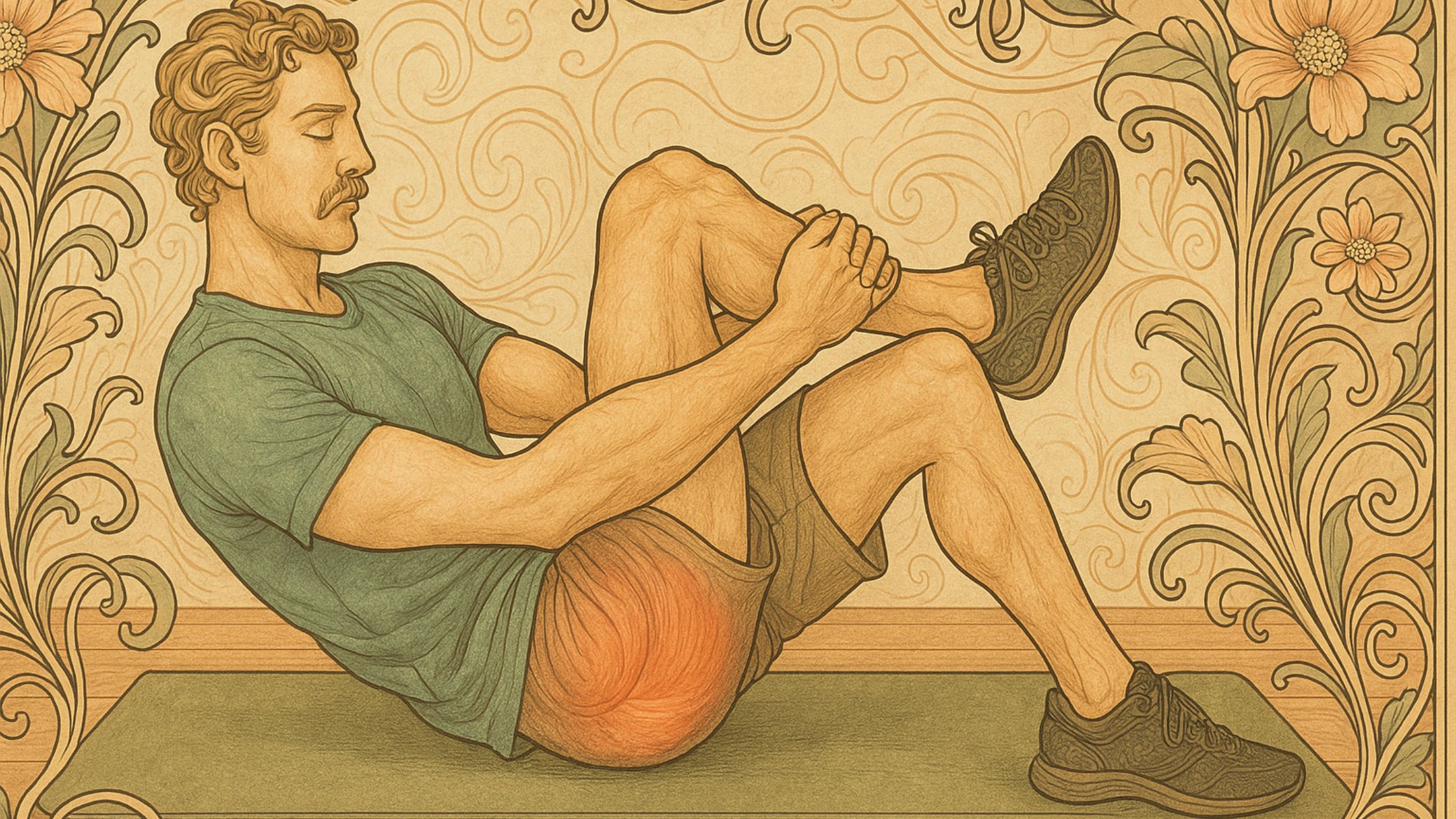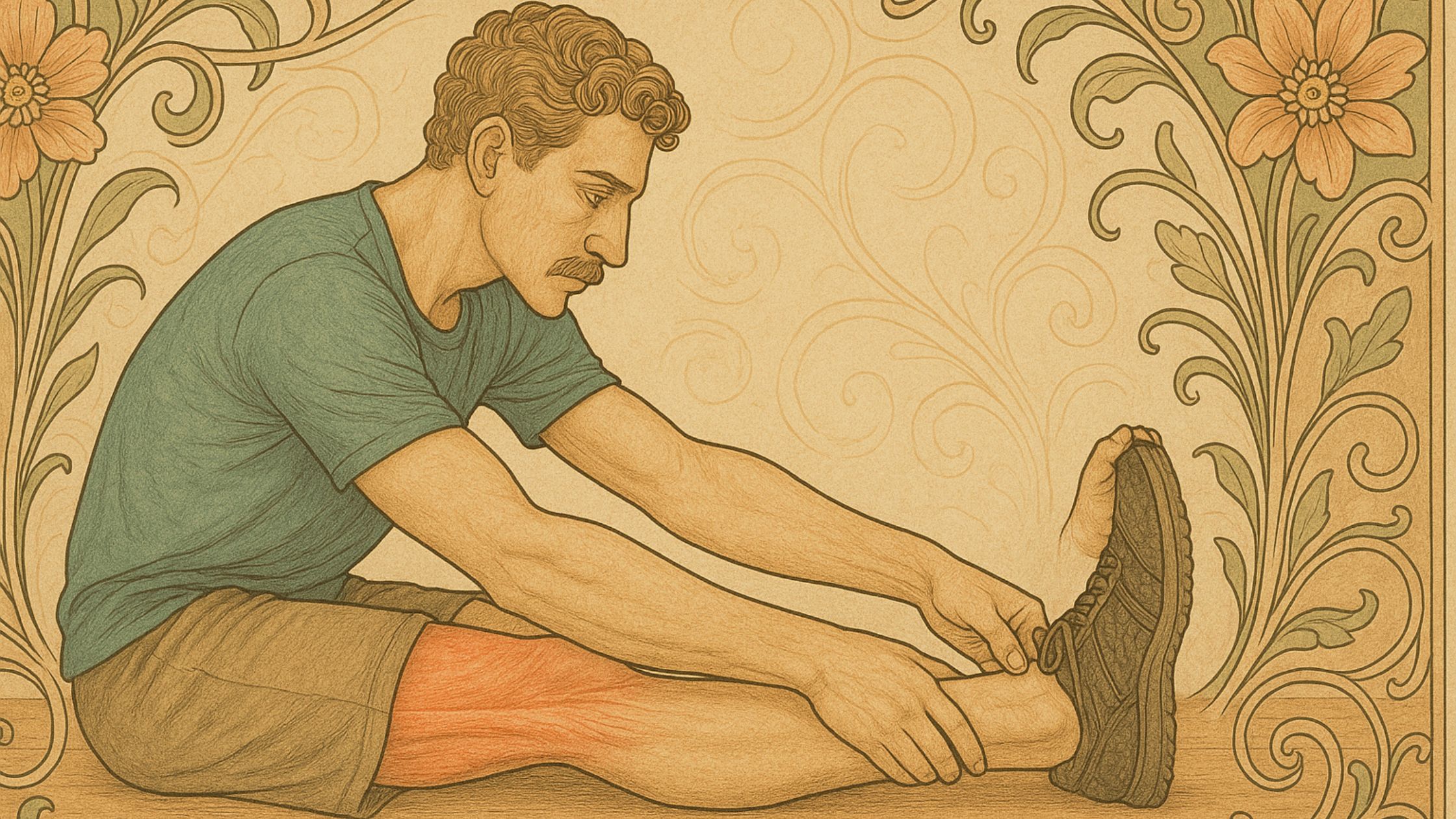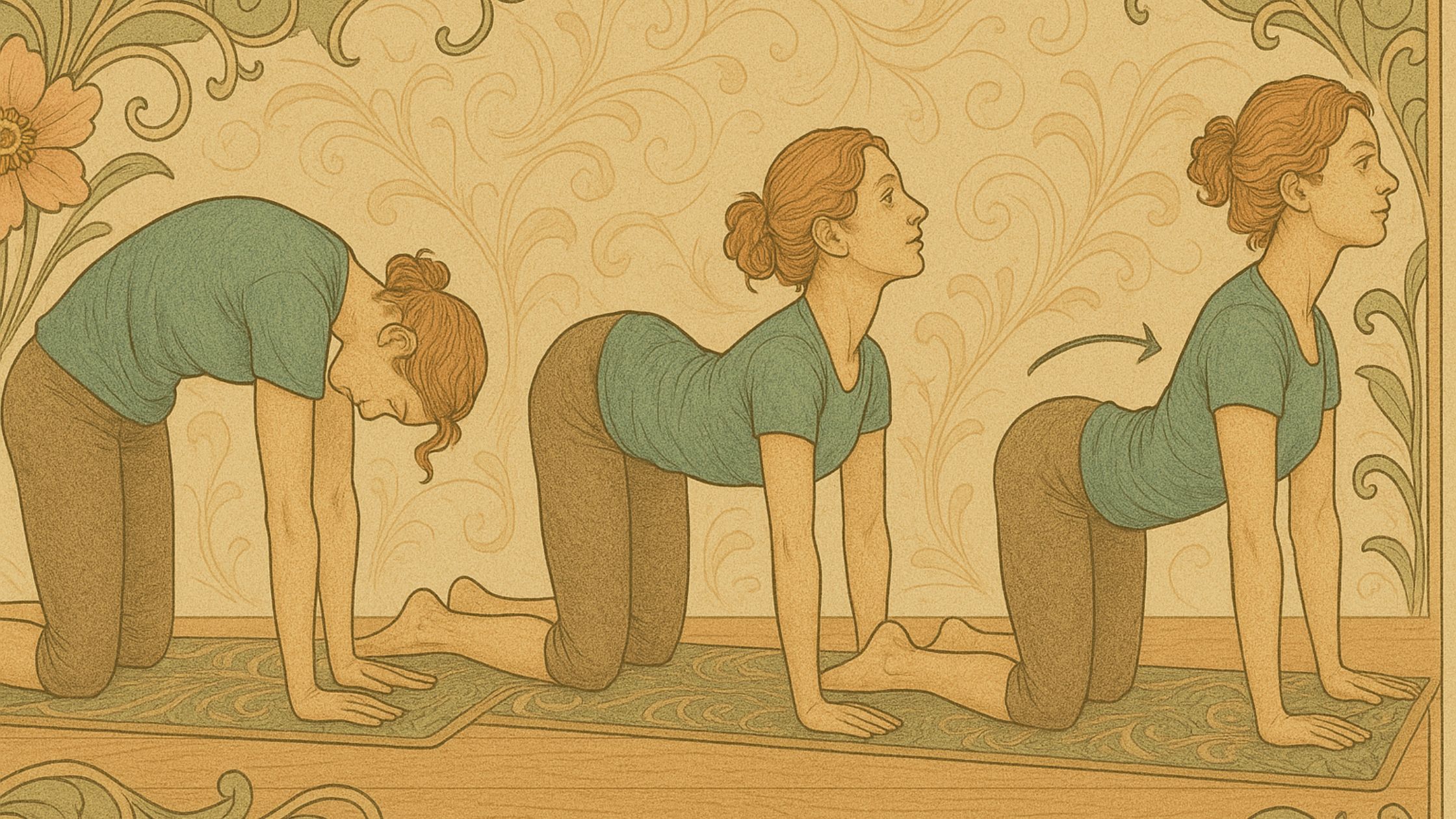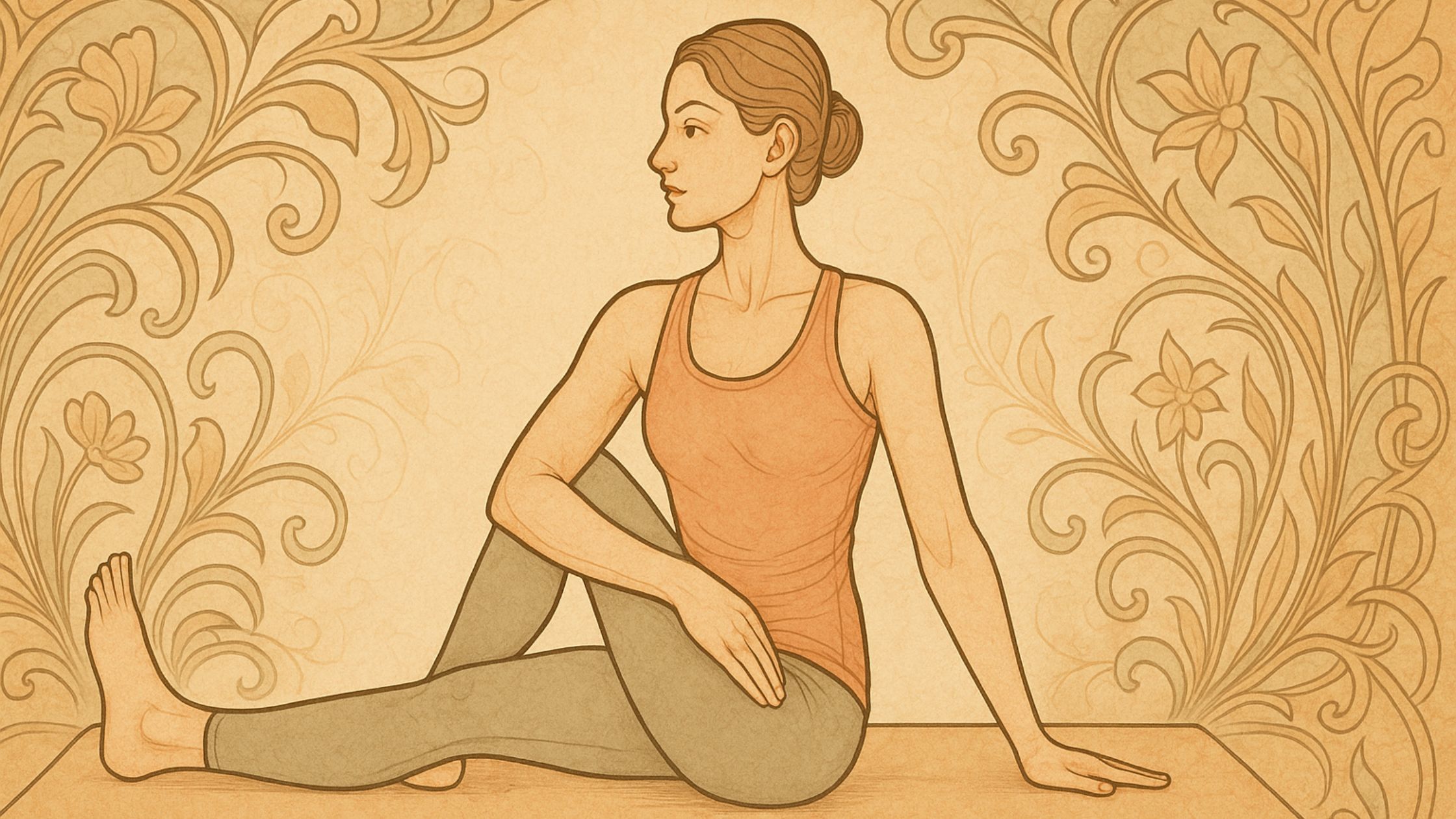In Canada, sciatic nerve pain is more common than many people realise. Studies estimate that between 10 % and 40 % of adults will experience sciatica at some point in their lives, and the condition typically strikes during the most active years.
Sciatica occurs when the large sciatic nerve, which runs from your lower back down your legs, becomes compressed or irritated.
Common culprits include herniated discs, spinal stenosis, or muscle spasms in the buttocks. The result can be a sharp, radiating pain that makes it hard to sit, stand or even sleep.
Anyone who has felt this stabbing sensation knows how quickly it can derail your day.
As alarming as this pain can be, the good news is that most cases of sciatica improve without surgery and often respond well to self‑care measures.
Many experts now recommend natural approaches—gentle stretching, movement and mindful breathing—as first‑line therapy before reaching for medication.
In fact, regular low‑impact exercise triggers the release of endorphins that naturally ease discomfort. So if you’ve been searching for natural sciatica relief that actually works, you’re in the right place.
This article walks you through a simple yet effective 10‑minute routine of sciatic nerve stretches designed to reduce pain quickly, plus home remedies for sciatica and lifestyle tips to keep flare‑ups at bay. By the end, you’ll have the tools to say goodbye to sciatic nerve pain in just 10 minutes—naturally.
Top 5 Over-the-Counter Products You Can Trust
| Product Name | Shop Online |
|---|---|
| Robaxin 750 Extra Strength Muscle Relaxant Tablets | Buy Now |
| Robaxacet Extra Strength | Buy Now |
| Motrin Platinum Muscle & Body Pain Relief | Buy Now |
| Dr Ho’s Decompression 2-in-1 Back Pain Relief Belt | Buy Now |
| Rub A535 Heat | Buy Now |
Understanding Sciatica | Causes, Symptoms and Prevalence
Sciatica refers to pain, numbness or tingling that follows the path of the sciatic nerve, the largest nerve in the body.
This nerve bundle originates from five nerve roots in the lower spine and runs through the buttocks and down each leg to the foot.
When one of these roots is compressed or irritated—by a herniated disc, spinal stenosis, degenerative disc disease or even muscle spasm—signals misfire and pain radiates.
A key reason this condition hurts so much is that the nerve is up to 2 centimetres wide, so even slight pressure can cause an electric‑shock sensation.
The table below summarises common causes of sciatic nerve pain, how they affect the nerve and what you can do at home for relief:
| Cause/Trigger | Effect on the Sciatic Nerve | Common Symptoms | Natural Relief Tip |
|---|---|---|---|
| Herniated disc | Bulging disc material presses on a nerve root | Sharp, shooting leg pain; worse with bending | Gentle sciatic nerve stretches to open space between vertebrae; try the piriformis stretch |
| Spinal stenosis | Narrowing of the spinal canal compresses the nerve | Pain while walking or standing; relieved by sitting | Short walks and pelvic tilts to keep joints mobile |
| Piriformis syndrome | Tight piriformis muscle traps the nerve | Aching buttock; tingling down the leg | Heat therapy followed by figure‑4 stretch |
| Injury or heavy lifting | Trauma or poor lifting mechanics strain the lower back | Sudden sharp pain radiating into leg | Rest briefly, then gentle movement and mindful breathing |
| Pregnancy & obesity | Increased weight and posture changes pressure the nerve | Lower back and leg pain, sometimes with numbness | Low‑impact exercise and supportive braces such as a decompression belt |
How Common Is Sciatica?
Sciatica is surprisingly prevalent. Estimates show a lifetime incidence of 10 % to 40 % and an annual incidence of about 1 % to 5 %.
The Cleveland Clinic notes that roughly 40 % of people in the United States will experience sciatica at some point, highlighting how widespread the problem is.
Most cases occur after age 30 as natural wear and tear or occupational stressors start to affect the spine, but injury‑related sciatica can strike younger adults.
Risk factors include normal aging, excess body weight, weak core muscles, physically demanding jobs or those that involve prolonged sitting, and conditions such as diabetes and smoking that impair circulation.
If you recognise yourself in these risk factors, adopting a proactive approach—staying active, strengthening your core and maintaining a healthy weight—can help prevent episodes.
Research also illuminates how people experience sciatica. One peer‑reviewed study reported that 63 % to 72 % of people feel pins and needles or tingling sensations, 35 % experience radiating pain, and 27 % report numbness.
These sensory disturbances often worsen with certain movements like bending, twisting or lifting. When symptoms linger beyond a few weeks or are accompanied by weakness, it’s wise to consult a healthcare professional for personalised guidance.
Recognising Symptoms and Why Fast Relief Matters
Sciatic nerve pain is characterised by more than just a sore back. The most common symptoms include:
Burning or electric‑shock pain that starts in the lower back or buttock and radiates down one leg. Tingling or “pins and needles” sensations along the thigh or calf.
Numbness in the affected leg or foot. Muscle weakness that makes it hard to lift the foot or toes. Severe cases may involve bowel or bladder dysfunction, signalling a medical emergency.
Because sciatica symptoms can be so disruptive—affecting work, sleep and mental health—fast relief is essential.
Fortunately, evidence shows that many people improve with conservative care and natural sciatica relief methods such as targeted stretching, heat and ice therapy, and core‑strengthening exercises.
Gentle movement not only lubricates joints but also triggers endorphin release, which acts as the body’s own painkiller.
In the next section we’ll dive into a 10‑minute routine designed to provide quick sciatica pain relief using safe, evidence‑based stretches.
If your pain persists despite these strategies, products such as Dr. Ho’s Decompression Belt and LivRelief Extra Strength Nerve Pain Relief Cream can offer additional support, and our pharmacists are always ready to help you choose the right solution.
The 10‑Minute Natural Method | Step‑by‑Step Guide
Sciatica can be incredibly disruptive, but relief doesn’t always require hours in a gym or prescription medications.
Many people find that a short, focused routine—performed gently and consistently—can dramatically reduce pain and improve mobility.
The following 10‑minute natural method combines stretches and mindful movement to target the muscles that commonly irritate the sciatic nerve.
Always move at your own pace, avoid bouncing, and stop if any exercise worsens your symptoms.
If you have severe or progressive neurological symptoms, consult a healthcare professional before beginning any exercise program.
1. Piriformis Stretch

The piriformis muscle runs deep in the buttock and sits directly over the sciatic nerve. Tightness in this muscle is a common culprit of sciatic nerve compression, and gently stretching it can provide quick sciatica pain relief.
- Starting position: Sit at the edge of a sturdy chair with both feet flat on the floor.
- Cross your leg: Place the ankle of your affected leg on the opposite knee so that your leg forms a figure‑4 shape.
- Lean forward: Keeping your back straight, gently lean forward from the hips until you feel a stretch in your buttock.
- Hold: Maintain the position for 20–30 seconds while breathing steadily, then slowly return to upright.
- Repeat: Switch legs and repeat. Do two rounds per side.
This seated version is gentle enough for most people and can be performed anywhere. Stretching the piriformis reduces pressure on the sciatic nerve and can relieve radiating pain.
2. Hamstring Stretch

Tight hamstrings pull on the pelvis and put tension on the lower back, which can exacerbate sciatic symptoms. Performing a safe hamstring stretch helps lengthen these muscles and reduce nerve irritation.
- Lying variation: Lie on your back with one leg extended on the floor. Loop a towel or strap around the foot of your opposite leg.
Gently pull your leg toward you, keeping your knee straight, until a comfortable stretch is felt in the back of your thigh. Hold for 20–30 seconds.
- Seated or standing variation: If lying down isn’t feasible, place your heel on a low stool or step, keeping your leg straight.
Bend forward slowly at the hips, maintaining a straight back, and reach toward your toes. Hold for 30 seconds.
- Repeat: Perform two rounds on each leg, breathing deeply. Consistent hamstring stretching promotes flexibility and reduces tension on the lumbar spine.
3. Cat‑Cow and Pelvic Tilt Sequence

This dynamic sequence mobilises the spine, warms up the back muscles and eases nerve compression. It’s often recommended in yoga and physiotherapy programs for natural sciatica relief.
- Get on all fours: Place your hands under your shoulders and knees under your hips.
- Cat pose: Inhale and round your spine toward the ceiling (like a cat), gently tucking your chin and tailbone.
- Cow pose: Exhale and slowly drop your belly toward the floor, arching your back and lifting your head and tailbone.
- Repeat: Flow between Cat and Cow for 8–10 deep breaths, moving with your breath.
- Pelvic tilt: After the Cat‑Cow sequence, lie on your back with knees bent and feet flat. Flatten your lower back into the floor, engaging your abdominal muscles. Hold for 5 seconds, then release. Repeat 8–10 times.
This combination improves spinal mobility and core engagement, which supports the lower back and reduces sciatic nerve irritation.
4. Figure‑4/Seated Spinal Stretch

A variation on the piriformis stretch, the figure‑4 pose also opens the hips and relieves tightness along the buttock and lower back.
Starting position: Lie on your back with knees bent.
Cross your leg: Place the ankle of your affected leg over the opposite thigh, making a figure‑4.
Pull your leg in: Reach your hands around the thigh of your supporting leg and gently pull it toward your chest until you feel a stretch in your hip and buttock.
Hold: Maintain for 20–30 seconds, breathing evenly.
Repeat: Switch legs and complete two rounds per side.
If lying down isn’t possible, the same shape can be made while seated: sit tall, cross your ankle over the opposite knee and gently hinge forward.
Completing two rounds of each stretch and the dynamic sequence typically takes about 10 minutes. Over time, you can repeat the routine two to three times per day, but always listen to your body and avoid pushing into pain.
Safety Tips and Next Steps
Warm up gently: Take a short walk or march in place for a minute before beginning to increase blood flow.
Mind your breathing: Steady, deep breaths promote relaxation and allow muscles to release tension.
Avoid bouncing: Stretch smoothly and hold positions without jerking to prevent injury.
Progress gradually: If you are new to exercise or have significant stiffness, start with shorter holds and fewer repetitions.
Consult professionals: If your pain is severe, persistent or accompanied by numbness or weakness in both legs, seek medical advice.
By dedicating just 10 minutes to this routine each day, many people experience reduced sciatic nerve irritation, improved flexibility and a greater sense of control over their pain.
Complementary Natural Remedies and Home Care
Conservative therapies can make a big difference in how quickly you recover from sciatica. Rather than relying solely on medication, many patients find relief through simple lifestyle adjustments and natural treatments that support healing.
The following approaches are evidence‑based, inexpensive and easy to incorporate into your daily routine.
Always speak with a healthcare professional before starting new therapies, particularly if you have underlying health conditions.
Heat and Ice Therapy
Applying cold and heat to the lower back and buttocks can reduce inflammation, ease muscle tension and promote circulation.
Harvard Health recommends starting with ice for the first few days after a flare‑up to calm swelling.
Cold packs: Wrap a cold pack or a bag of frozen peas in a towel and place it on your lower back for 15–20 minutes. Allow the skin to warm for at least 15 minutes before reapplying.
Try a cycle of 20 minutes on, 20 minutes off, repeated three to five times per day. A gentle ice massage—freezing water in a paper cup and massaging in circles—can also be effective.
Heat therapy: Once the acute pain subsides, apply a warm (not hot) heating pad or hot water bottle to the same area for 15–30 minutes.
Heat increases blood flow, relaxes tight muscles and prepares tissues for stretching. Protect your skin with a cloth barrier and avoid sleeping with the heating pad to prevent burns.
A warm bath is another soothing option.
Gentle Exercise & Yoga
Staying active is one of the most effective long‑term strategies for home remedies for sciatica. Resting for more than a day or two can weaken muscles and increase stiffness.
Redefine HealthCare notes that low‑impact activities such as water aerobics, stationary biking and yoga can reduce symptom severity and build supportive back muscles.
Exercise triggers the release of endorphins—your body’s natural painkillers.
Some movement suggestions:
- Short walks: Begin with five‑minute walks a few times a day, gradually increasing duration. Walking strengthens muscles and improves circulation without jarring the spine.
- Water aerobics or swimming: The buoyancy of water reduces pressure on the spine while allowing full‑body movement.
- Gentle yoga poses: Incorporate stretches like the reclined pigeon pose, supine twist and seated forward bend, holding each for five deep breaths.
These poses improve hip flexibility and relieve tension along the sciatic pathway. Avoid any movements that cause sharp pain.
Daily stretching routine: Continue performing the 10‑minute routine described above. Consistent stretching supports flexibility and helps prevent future episodes of sciatic nerve pain.
Topical Analgesics and Supplements
Topical products and dietary supplements offer additional support, especially for people seeking natural sciatica relief.
Topical creams and gels: Creams containing menthol, capsaicin or arnica provide a cooling or warming sensation that may relieve nerve pain.
For example, LivRelief Extra Strength Nerve Pain Relief Cream contains capsaicin, hypericum and arnica to deliver rapid relief.
Apply a small amount directly to the painful area up to three times daily. Always follow the manufacturer’s instructions and test on a small patch of skin first.
Herbal supplements: Turmeric (curcumin), omega‑3 fatty acids, and magnesium have anti‑inflammatory properties and are commonly taken to reduce nerve pain.
Evidence is still emerging, so consult a healthcare provider before starting supplements, especially if you take other medications.
Vitamins: Adequate vitamin D and vitamin B12 levels support nerve health and reduce inflammation. You can obtain these through diet (fatty fish, fortified foods) or supplements.
When to Seek Professional Help
Most people recover from sciatica within a few weeks. However, some symptoms warrant medical evaluation. WebMD advises seeing a doctor if you experience any of the following red flags:
- Severe or worsening pain that doesn’t improve after a week or interferes with daily activities.
- Numbness or weakness in the leg, pelvis or lower body.
- Loss of bladder or bowel control, or difficulty urinating.
- Fever, swelling, or redness in your back or spine.
- Blood in your urine or burning during urination.
If your pain persists or worsens despite home care, consult your family doctor or a physiotherapist.
They can evaluate your symptoms, rule out serious conditions like cauda equina syndrome, and suggest treatments such as prescription medications, physical therapy, spinal injections or, in rare cases, surgery.
Chiropractors, osteopaths, and massage therapists can also provide relief through manual therapy and targeted exercises.
Always seek immediate medical attention if you experience sudden loss of sensation, significant weakness, or incontinence.
Conclusion
Sciatic nerve pain affects a significant portion of the population, but with the right combination of targeted stretches, exercises for sciatica pain, and supportive lifestyle habits, it’s possible to reduce discomfort and regain mobility.
Start by incorporating the 10‑minute natural method into your daily routine, supplement it with gentle exercise and home care, and make ergonomic adjustments to prevent future flare‑ups.
If symptoms persist or red flags appear, seek professional evaluation to rule out serious conditions.
For additional support, explore Pharmacy24’s range of pain‑relief products and wellness resources—our pharmacists are ready to help you find personalised solutions for lasting relief.
